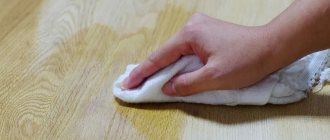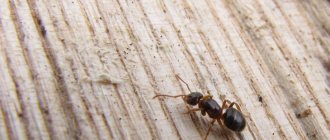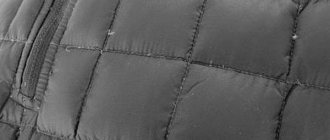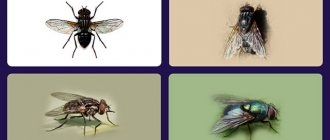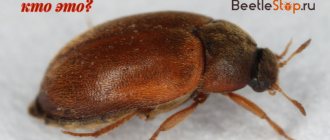Small bugs in the kitchen or pantry mean a lot of problems: a long, but not always effective battle with intrusive pests and a large number of spoiled products. Even the most clean housewives are faced with this disaster on a local scale.
Systematic wet cleaning and checking food lockers will not solve the problem. In order to find out how to get rid of bugs in cereals, you need to understand the reason for their appearance. This is the only way to stop another invasion in the future.
Causes of flour bugs
The most common reason is non-compliance with technological and sanitary standards during food production. Therefore, no one is immune from such a nuisance.
Initially, insects enter the house with dry food, and then quickly spread throughout the kitchen. Pests colonize near food, but are found in cracks, latches and other hidden places.
This is interesting: most insects are so small that they are difficult to notice with the naked eye. They camouflage themselves with the color and shape of the environment in which they live.
In everyday life, bugs appear in cereals or other products if:
- Containers for storing bulk solids are selected incorrectly. Preference should be given to glass and plastic containers with fully screw-on lids or a vacuum effect. An inexpensive alternative is to use plastic bags that must be tied. Limited contact with air and dampness allows you to preserve food longer and prevent insects from accessing it.
- The expiration date has expired. All food products have a specific shelf life. Information about this is indicated on the packaging. Goods sold by weight are fraught with danger, since the actual date of their production and sorting cannot be determined.
- Conditions of detention are not met. A warm, damp atmosphere in a closet or indoors, if we are talking about a pantry, is a favorable factor for the intensive reproduction of cereal bugs. In this regard, air temperature and humidity play an important role when choosing a place to store bulk products.
Advice: it is recommended not to make large reserves unless absolutely necessary, but to limit yourself to moderate volumes and look into the bins more often.
Pest insects like to nest in:
- various cereals;
- pasta;
- flour;
- loose leaf tea;
- granulated or ground coffee;
- dried fruits;
- spices
In order to promptly notice the presence of an “inedible impurity” in a product, you need to know what exactly to look for, that is, what the bugs look like.
Important: the main danger lies not even in food spoilage, but in the allergic reaction or food poisoning that they can provoke.
Note to housewives
To avoid having to fight parasites, it is advisable to insure yourself against their occurrence in advance. In order not to rack your brains over how to remove them, you need to maintain cleanliness, ensuring periodic ventilation of the cabinets. If the furniture products are highly airtight, then the air circulation in them does not matter; you should constantly ventilate the furniture by opening the cabinets for a short time. Other preventive measures:
- Avoid storing groceries in large quantities. This will not save you from bugs in flour and cereals, but it will significantly reduce the damage if parasites do settle in.
- Use airtight containers, glass and plastic, and tight lids.
- If there are large reserves, dust should be used. It is available in markets and stores. This substance crumbles onto the floor and under bags. Dust repels insects, but is completely safe for people.
- Different products should be kept separately, not storing everything on a single shelf. For example, it is better to hide dried fruits away from cereals.
- Garlic is an effective preventative. You should put one slice of it in each jar of cereal. You can place dry bay leaves between the jars; parasites do not like its smell.
Garlic with laurel
- If cereals are stored in textile bags, you can “salt” these products. For this purpose, prepare a salt solution (2 tablespoons per 1 liter), then soak the bags in it. After 30 minutes, these bags should be taken out and dried. After this treatment, pests do not approach the bags.
What kind of bugs are there in cereals?
The most common types of parasites in the kitchen have different names, but they cause the same harm.
Flour bugs: photo
The red mucoed of Suriname has a brown color. An adult reaches 2 mm in size. In addition to grain processing products, they prefer concentrates, cookies and some cereals in their daily menu. That's why you need to look everywhere.
Insects reproduce quickly and their clutches are impossible to find with the naked eye. Therefore, it is recommended to get rid of the product in which mucoeds were found.
Small Khrushchak
The red-brown flour beetle with small antennae and wings is not able to fly. Body length up to 3 mm. There is a relatively slow pace of reproduction - 4 broods per year. Most of all he loves flour, rice, semolina, buckwheat, millet and Artek waffles.
The colony lives close to food supplies. As a rule, it lives in furniture and dishes.
Important: this type of pest is difficult to remove and easily adapts to any living conditions.
Bread grinders
Insects are cylindrical in shape with a light brown or brown color. They reach 3-3.5 mm in length and are covered with short hairs. The only way to find them in the house is to find them dead on the windowsill. Traces of human activity are found in books, furniture and on shelves. They eat any nuts, cereals, grains, dried fruits and even plants.
food moth
It differs from other representatives of its species, which prefer woolen products, in that it feeds on grain crops and dried fruits. A kind of vegetarian moth.
It reaches a maximum size of 1 cm, looks like a large midge and is enviably fertile - it lays up to 500 eggs in 2 weeks. Eats food at incredible speed, flies and camouflages.
Weevils
Universal pests that eat not only bulk, dry foods and flour products, but also fresh fruits and vegetables. Black beetles grow up to 5 mm long and have a noticeable proboscis. They move freely along walls and fly. They live in containers with provisions, in the corners of closed furniture, and less often in bedding.
Southern barn moths
At first glance they resemble brown moths, but they feed mainly on walnuts, chocolate and dried fruits. If there is a large amount of dried apples, these pests will first turn their attention to them. Slices of fruit turn into dry lumps wrapped in silk with an unpleasant odor.
When looking for fires, you should pay attention to the ceilings of closets or rooms. After hatching, the caterpillars prefer to pupate in such places.
Can there be cockroaches in cereals?
These most popular and intrusive pests also feed on bulk dry foods. But they usually start in the house differently than, for example, flour beetles or bread borers. They are primarily scavengers and feed on food scraps, living near sinks, bins and cutting tables.
Where are the bugs hiding?
If insects appear in the kitchen, then general cleaning is essential. We'll have to check everything. After all, kitchen pests are practically omnivorous. Neither red pepper nor medicinal herbs scare them.
Note! It is best to complete the search in one day because the bugs can multiply quickly.
The work plan is as follows:
- Sort through all the cereals. If living creatures were found in open packages, then most likely they have already gnawed through the sealed products. Open and check everything!
- Don't forget to check the salt. Perhaps the emerging insects are not connoisseurs of sweets.
- Beans are a favorite delicacy. If dark spots appear on the beans, throw them away. In the future, try to store beans only in the freezer.
- Check all the seasonings and first aid kit. Kitchen pests are partial to ordinary mustard plasters. Be sure to review all packaging.
- Don't forget about tea and coffee. A floating insect in a cup is quite a sight!
- Sort through all the vegetables. Some beetles do not disdain onions.
- Move all the furniture and check the cracks. If during this time you managed to find several clusters of beetles, you will have to check the entire apartment.
- Inspect the window sills and floors.
- Check all equipment. Don't even ignore the iron.
How to get rid of bugs in cereals in different ways
If pests are found in cereals or other products, you need to start fighting them immediately. The simplest way is to dispose of spoiled food. You should pour everything into a bag, tie it tightly and place it in another one of the same kind.
Important: after some of the supplies have been thrown away, a thorough cleaning is carried out, that is, wet cleaning of all kitchen furniture and treatment with vinegar, soda or bleach.
When bugs in cereals have become a real problem and are not eliminated by throwing away the affected products, you have to resort to radical measures.
How to prepare bait from borax or boric acid
If there are insects in cereals, one folk recipe for homemade bait will help:
- You will need borax or boric acid, semolina and powdered sugar. Mix everything in equal quantities.
- Sprinkle the resulting mixture on all horizontal surfaces. Particular attention should be paid to the place where the pests were found.
The flour-eating beetle dies immediately. Other bugs, larger ones, still run around, but will inevitably die. Insects cannot tolerate boric acid, and sweets will attract them to the trap.
Important: this method can be dangerous if there are pets or a child in the house. The active substance, once in the mucous membrane, will cause severe irritation, and through the oral cavity - poisoning.
Thermal fighting
Small insects do not tolerate sudden changes in temperature, frost and heat. If you find pests in winter, it is enough to take the cereals out onto the balcony. But at the same time, the mercury column should show no higher than -15 °C. After a couple of hours, all insects will die. This method is especially relevant in order to remove beetles that have taken up residence in flour or semolina, but at the same time preserve food.
For cereals, the opposite method is suitable - exposure to heat. Pour the product onto a baking sheet and place it in the oven. At a temperature of +50 °C, the uninvited “tenants” will die within 15 minutes. But to be sure, they recommend holding it for 30 minutes.
Exposure to water and sun
When there is no time or suitable conditions, an alternative option is suitable: take the amount of cereal needed for cooking and add hot water. This method is suitable for quickly ridding pasta and bulk food products of most small insects. The pests will float up dead, just drain them and repeat the procedure.
When bugs appear in flour, it is not immediately possible to determine what to do with the ingredient for many dishes. It's a shame to throw away a large amount. There is a way out of this situation: you need to take it outside. Mucoeds are afraid of ultraviolet radiation. Under the influence of sunlight, they will run away after 10 minutes. But don't relax. It will not be superfluous to sift the purified product twice.
Salt
Washing cereals with salted water gives good results. All pests float to the surface, but after this you need to repeat the procedure with regular liquid without impurities. The method is even suitable for oatmeal, but it must be cooked immediately.
Table vinegar
Used for wet cleaning after getting rid of insects. The pungent odor of the substance will protect against new pests and drive away those remaining after persecution. Surfaces are treated with a solution of laundry soap, vinegar essence and boiling water.
Strong odors
All insects are afraid of strong odors. They are not able to destroy pests, but will drive them away for a while. Garlic, bay leaves, dry lavender, wormwood and sage will cope with this. The herbs are laid out after thorough wet cleaning in the former habitats of the bugs.
More humane ways (for pensioners)
Here we are not talking about humanity towards bugs, but about humanity towards provisions, and therefore towards pensioners. Still, if you don’t have enough money, throwing away the cereal is simply the height of madness.
Therefore, you can use this method of struggle:
- Step 1. Sift the cereal through a fine sieve and sort thoroughly.
- Step 2. Then bake it in the oven or put the bags in the freezer for 3-4 days.
- Step 3: Try to use this grain as quickly as possible.
- Step 4. Still treat the cabinets, floor and other surfaces. If you can’t use chemicals, then at least wipe it with vinegar, pour boiling water over the cracks, or you can use laundry soap (rub it and make a soap solution). You can also make a solution of boric acid.
- Step 5. Be sure to wash the dishes, as there may be larvae there.
After you put the grains back in the box, you can place “traps” there. Pour sunflower oil into the caps and the remaining bugs will certainly taste this treat. And they will drown in it, and you will simply fly out this oil and that’s it.
Then, you can place bay leaves and garlic in the cabinets. We don’t guarantee that this is very effective and will help remove the bugs forever, but it calms the soul.
How to fight and get rid of insects using chemical means
You can get rid of insects in an apartment not only with folk remedies. But chemicals cannot be used to clean cereals, as they pose a danger to humans. Once in the body with food, the toxin can cause acute poisoning, at a minimum.
Insecticides in the form of emulsions and aerosols are sprayed in rooms from which all products have already been removed. The procedure is usually carried out as one of the points in a comprehensive pest persecution plan. After treatment, it is forbidden to stay in the room for some time if it is not ventilated, but food cannot be stored for even longer.
The only substance of this type that is relatively safe for humans is Pyrethrum. The natural insecticide is based on Dalmatian chamomile and is often used to treat indoor plants.
Important: the use of chemicals is carried out exclusively in accordance with the instructions on the packaging.
Why did uninvited guests appear?
Where do insects in the form of flour bugs come from?
Their celebration of life does not begin on its own, and 3 reasons contribute to this:
Contaminated product
You should not think that any “evil spirits” will not appear in a product from a trusted store. It can enter the buyer’s home after contamination of cereals during production, during transportation and directly at retail outlets.
"Gift" from neighbors
Bugs often end up in another habitat in this way. It is enough for them to find themselves in a glass of emergency help when, if it is impossible to visit the store, you ask your neighbors for something. On one landing, people are not averse to sharing flour and other products if they are on good terms. After all, next time they will not be denied their request either.
Tricky used furniture
After purchasing this part of the interior, you should then wait for a problem to appear; a bug may be hiding there. Not in all cases the outcome of events will look like this, but it won’t hurt to prepare for it. In a new place, insects quickly settle down, which is not something to doubt. In this case, it is easy to drive them away by using special methods.
Is it possible to eat contaminated cereals and flour?
Some people are disgusted to even touch such a product, let alone consume it, because we are talking about health. It is not recommended to use spoiled cereals for making porridge.
Even after washing, eggs, larvae, their husks and excrement may remain. All this will not bring any benefit; moreover, it can cause unpleasant consequences in the form of poisoning or allergies.
It's a little easier with flour. Using a fine sieve can get rid of all this debris. The final disinfection of flour is carried out using an oven at a temperature of +50 °C.
General cleaning as a method of pest control
Pests can also be removed by thoroughly cleaning their habitat. But subject to the obligatory condition of disposal of affected products.
What do we have to do:
- Empty the cabinet or shelf of its contents. Clean everything inside with a soapy vinegar solution. Pay special attention to food residues that often spill out in storage areas.
- Pour boiling water over all containers.
- Wash fabric bags in salt water.
- For adult individuals, it is better to use special traps.
Plants with a pungent odor also show good results in the fight against insects. These include mint, lavender, lemon balm and others. Soaking cloth strips in extracts will help prevent a new insect infestation. The main thing is not to forget to update your feeds.
Recycling is a simple and reliable method
When there is neither the desire nor the ability to fight the increasing population of harmful insects in bulk products in the kitchen, it is worth moving on to a radical method - recycling damaged cereals.
Packages, sacks, containers with bugs are carefully packed in sealed cellophane and taken out of the house.
Places where contaminated products were stored (shelves, cabinets, mezzanines) are thoroughly treated with soda, vinegar or chlorine solution, followed by rinsing with clean water.
Prevention of occurrence
It is easier to avoid the appearance of any insects with the help of simple manipulations than to then spend a lot of time and effort fighting them.
Tips on how to prevent beetles:
- When buying bulk products, look at the production date and expiration date.
- Check the packaging for integrity.
- If possible, inspect the product for quality (presence of debris) and the presence of living creatures in it.
- Regularly clean food storage areas.
- It is better to keep bulk products in plastic or glass, but always transparent containers. This makes it easier to control the presence of inedible additives in it.
By taking standard precautions when purchasing food, you can protect your home from insect infestations. You should not stock up on cereals, flour, or pasta for future use. Large amounts of food are harder to keep track of.
Did you like the article? Save it to your Pinterest! Hover over the image and click “Save.”
How to prevent a new invasion?
There's no way you can prevent this. Little depends on cleanliness; rather, it depends on attentiveness.
The only thing that can be recommended is to keep cereals in hermetically sealed glass jars, specially designed for storing bulk products (here is a good article on this topic).
Although this is not a panacea, at least then they won’t scatter to other places.
Also, be sure to close the packages with spices, even with regular paper clips.
In general, there is only one prevention: just try not to buy anything for future use. It’s probably not 1917, and you can go to the store at any time. It is better to buy less and a little more expensive than a lot, cheaply, but send half to feed the yard dogs.

